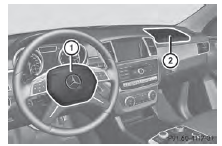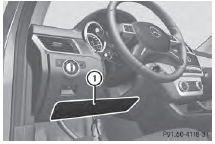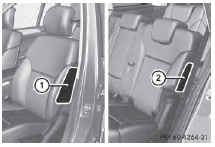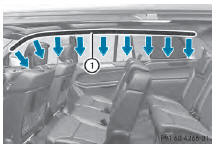Air bags
Important safety notes
WARNING
Air bags are designed to reduce the incidence
of injuries and fatalities in certain situations:
• frontal impacts (driver's and frontpassenger
front air bags and driver's knee
bag)
• side impacts (side impact air bags and
window curtain air bags)
• rollover (window curtain air bags)
However, no system available today can completely eliminate injuries and fatalities.
When the air bags are deployed, a small amount of powder is released. The powder generally does not constitute a health hazard and does not indicate that there is a fire in the vehicle. In order to prevent potential breathing difficulties, you should leave the vehicle as soon as it is safe to do so. If you have any breathing difficulty but cannot get out of the vehicle after the air bag inflates, then get fresh air by opening a window or door.
WARNING
In order to reduce the potential danger of injuries caused during the deployment of the front air bags, the driver and front passenger must always be correctly seated and wear their seat belts.
For maximum protection in the event of a collision, you must always be in the normal seat position with your back against the backrest. Fasten your seat belt and make sure that it is correctly positioned on your body.
As the air bag inflates with considerable speed and force, a proper seating position and correct positioning of the hands on the steering wheel will help to keep you at a safe distance from the air bag. Occupants who are not wearing their seat belt, are not seated properly or are too close to the air bag can be seriously injured or killed by an air bag, as it inflates with great force instantaneously:
• sit with the seat belt fastened correctly and in a position that is as upright as possible with your back against the backrest.
• move the driver's seat as far back as possible, still permitting proper operation of vehicle controls. The distance from the center of the driver's chest to the center of the air bag cover on the steering wheel must be at least 10 inches (25 cm). You should be able to accomplish this by adjusting the seat and steering wheel. If you have any difficulties, please contact an authorized Mercedes-Benz Center.
• do not lean your head or chest close to the steering wheel or dashboard.
• only hold the steering wheel on the outside.
Placing hands and arms inside the rim can increase the risk and potential severity of hand/arm injury if the driver front air bag inflates.
• adjust the front-passenger seat as far back as possible from the dashboard when the seat is occupied.
• occupants, especially children, should never place their bodies or lean their heads in the area of the door where the side impact air bag inflates. This could result in serious or fatal injuries should the side impact air bag be deployed. Always sit as upright as possible, wear the seat belt properly and use an appropriately sized infant restraint, toddler restraint or booster seat recommended for the size and weight of the child.
Failure to follow these instructions can result in severe injuries to you or other occupants.
If you sell your vehicle, it is important that you make the buyer aware of this safety information. Be sure to give the buyer this Operator's Manual.
WARNING
Accident research shows that the safest place for children in an automobile is in a rear seat.
A side impact air bag related injury may occur if occupants, especially children, are not properly seated or restrained when next to a side impact air bag which needs to deploy rapidly in a side impact in order to do its job.
To help avoid the possibility of injury, please follow these guidelines:
(1) Always sit as upright as possible and use the seat belts properly.
Make sure that children 12 years old and under use an appropriately sized child restraint, infant restraint, or booster seat recommended for the size and weight of the child.
(2) Always wear seat belts properly.
If the air bags are deployed, you will hear a
bang, and a small amount of powder may also
be released. Only in rare cases will the bang
affect your hearing. The powder that is
released generally does not constitute a
health hazard. The  SRS warning lamp
SRS warning lamp
lights up.
The air bags are deployed if the air bag control unit detects the need for deployment. Only in the event of such a situation will the air bags provide their supplemental protection.
If the driver and front passenger do not wear their seat belts, it is not possible for the air bags to provide their supplemental protection.
In the event of other types of impacts and impacts below air bag deployment thresholds, the air bags will not deploy. The driver and passengers will then be protected to the extent possible by a properly fastened seat belt. A properly fastened seat belt is also needed to provide the best possible protection in a rollover.
Air bags provide additional protection; they are not, however, a substitute for seat belts.
All vehicle occupants must fasten their seat belts regardless of whether your vehicle is equipped with air bags or not.
It is important for your safety and that of your passengers to have deployed air bags replaced and to have any malfunctioning air bags repaired. This will help to make sure the air bags continue to perform their protective function for the vehicle occupants in the event of a crash.
Front air bags

Driver's air bag 1 deploys in front of the steering wheel; front-passenger front air bag 2 deploys in front of and above the glove box.
The front air bags increase protection for the driver's and front-passenger's head and chest.
They are deployed:
• in the event of certain frontal impacts
• if the system determines that air bag
deployment can offer additional protection
to that provided by the seat belt
• depending on whether the seat belt is being
used
• independently of other air bags in the
vehicle
If the vehicle overturns, the front air bags are
generally not deployed. If the system detects
high vehicle deceleration in a longitudinal
direction, the front air bags are deployed.
When a child restraint system is installed on
the front-passenger seat and the
PASSENGER AIRBAG OFF indicator lamp in
the center console does not light up:
• a child restraint system without a
transponder for the air bag deactivation
system is installed or
• a child restraint system with a transponder
has not been installed properly.
Your vehicle has adaptive, two-stage front air bags. In the event of a collision, the air bag control unit evaluates the vehicle deceleration. In the first deployment stage, the front air bag is filled with enough propellant gas to reduce the risk of injuries.
The front air bag is fully deployed if a second deployment threshold is exceeded within a few milliseconds.
The deployment of front-passenger front air bag 2 is also influenced by the weight category of the front passenger, which is determined by the Occupant Classification System (OCS).
The lighter the passenger side occupant, the higher the vehicle deceleration rate required (predicted at the start of the impact) for second-stage inflation of the front-passenger front air bag. In the second stage, the front air bags are inflated with the maximum amount of propellant gas available.
The front air bags are not deployed in situations where a low impact severity is predicted. You will then be protected by the fastened seat belt.
Front-passenger front air bag 2 will only deploy if: Rthe system, based on the OCS weight sensor readings, has detected that the front-passenger seat is occupied.
Rthe  indicator lamp on the center
indicator lamp on the center
console is not lit .
Rthe air bag control unit predicts a high impact severity.
Driver's knee bag

Driver's knee bag : deploys under the steering column. The driver's knee bag is always deployed along with the driver's front air bag. The driver's knee bag is designed to operate together with the front air bags in frontal impacts if certain thresholds are exceeded. The driver's knee bag operates best in conjunction with correctly positioned and fastened seat belts.
The driver's knee bag increases protection of
the driver against:
• knee injuries
• thigh injuries
• lower leg injuries
Side impact air bags
WARNING
Only use seat covers which have been tested and approved by Mercedes-Benz for your vehicle model. Using other seat covers may interfere with or prevent the deployment of the side impact air bags. Contact an authorized Mercedes-Benz Center for availability.
WARNING
The pressure sensors for side impact air bag control are located in the doors. Do not modify any components of the doors or door trim panels including, for example, the addition of door speakers.
Improper repair work on the doors or the modification or addition of components to the doors create a risk of rendering the side impact air bags inoperative or causing unintended air bag deployment. Work on the doors must therefore only be performed by qualified technicians. Contact an authorized Mercedes-Benz Center.

Front side impact air bags : and side impact air bags in the 2nd row of seats ; inflate next to the outer seat cushion.
When deployed, the side impact air bags offer
additional protection for the thorax and, on
the front seats, the pelvis of the vehicle
occupants on the side of the vehicle on which
the impact occurs. However, they do not
protect the:
• head
• neck
• arms
The side impact air bags are deployed:
• on the side on which an impact occurs
• at the start of an accident with a high rate
of lateral vehicle deceleration or
acceleration, e.g. in a side impact
• regardless of whether the seat belt on the
driver's seat and the outer seats of the 2nd
row of seats is used
• independently of the front air bags
• independently of the ETDs
If the vehicle rolls over, the side impact air bags are generally not deployed. side impact air bags are deployed if the system detects high vehicle deceleration or acceleration in a lateral direction, or also if the vehicle rolls over, and the system determines that side impact air bag deployment can offer additional protection to that provided by the seat belt.
Side impact air bags will not deploy in side impacts which do not exceed the system's preset deployment thresholds for lateral acceleration/deceleration. You will then be protected by the fastened seat belt.
The side impact air bag on the frontpassenger side is not deployed in the following situations:
• the OCS system detects that the frontpassenger seat is not occupied, and • the front-passenger seat belt is not fastened.
The side impact air bag on the frontpassenger side will deploy if the frontpassenger seat belt is fastened, regardless of whether the front-passenger seat is occupied or not.
Window curtain air bags

Window curtain air bags 1 enhance the level of protection for the head, but not chest or arms, of the vehicle occupants on the side of the vehicle on which the impact occurs.
The window curtain air bags are integrated into the side of the roof frame and deploy in the area extending from the front door (Apillar) to the rear side window (D-pillar).
Window curtain air bags are deployed:
• at the start of an accident with a high rate
of lateral vehicle deceleration or
acceleration, e.g. in a side impact
• on the side on which an impact occurs
• on the driver's side and passenger side, in
the event of a vehicle rollover and if the
system determines that air bag deployment
can offer the vehicle occupants additional
protection to that provided by the seat belt
• independently of the use of the seat belt
• regardless of whether the front-passenger
seat is occupied
• independently of the front air bags
Window curtain air bags 1 will not deploy in
the event of impacts which do not exceed the
system's preset deployment thresholds for
vehicle acceleration/deceleration. You will
then be protected by the fastened seat belt.
See also:
Coupling up a trailer
Do not connect the trailer's brake system
(if featured) to the hydraulic brake system
of the towing vehicle, as the latter is
equipped with an anti-lock brake system.
Doing so will result in a l ...
ABS (Anti-lock Braking System)
Important safety notes
Observe the "Important safety notes" section .
WARNING
If ABS is faulty, the wheels could lock when
braking. The steerability and braking
characteristics ma ...
115 V socket
WARNING
The 115 V AC power socket operates on high
voltage. Use the 115 V AC power socket in
the vehicle with the same caution and care
that you would take with power sockets at
home. Keep fluids ...
